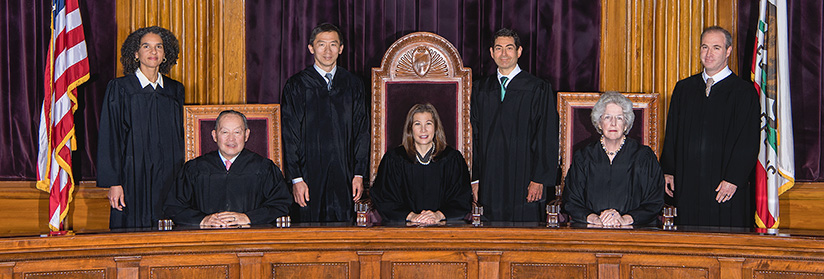
California Supreme Court Justices (courts.ca.gov)
Constitutional Provisions Related to the Judiciary
The judicial branch of government was added to the California Constitution in 1966
By Chris Micheli, June 4, 2022 7:32 am
Just as with the federal government, there are three branches of state government in California. Each branch is set forth in the state Constitution. Article 6, dealing with the judicial branch of government, was added to the California Constitution by Proposition 10a on the November 8, 1966 ballot. This Article contains the following twenty-two sections:
Section 1 provides that the judicial power of the state is vested in the Supreme Court, courts of appeal, and superior courts, all of which are courts of record.
Section 2 provides that the Supreme Court consists of the Chief Justice and 6 associate justices and the agreement of four judges present at the argument is necessary for a judgment.
Section 3 provides that the Legislature must divide the state into districts with each containing a court of appeal with one or more divisions and that each division consists of a presiding justice and 2 or more associate justices.
Section 4 provides that, in each county of the state, there is a superior court of one or more judges and the Legislature prescribes the number of judges and provides for the officers and employees of each superior court.
Section 6 provides that the Judicial Council consists of the Chief Justice and one other judge of the Supreme Court, three judges of the courts of appeal, 10 judges of the superior courts, two nonvoting court administrators, and any other nonvoting members as determined by the voting membership of the Council.
Section 7 provides that the Commission on Judicial Appointments consists of the Chief Justice, the Attorney General, and the presiding justice of the court of appeal of the affected district or, if there are 2 or more presiding justices, the one who has presided longest or, when a nomination or appointment to the Supreme Court is to be considered, the presiding justice who has presided longest on any court of appeal.
Section 8 provides that the Commission on Judicial Performance consists of one judge of a court of appeal and two judges of superior courts, each appointed by the Supreme Court; two members of the State Bar of California who have practiced law in this State for 10 years, each appointed by the Governor; and, six citizens who are not judges, retired judges, or members of the State Bar of California, two of whom to be appointed by the Governor, two by the Senate Committee on Rules, and two by the Speaker of the Assembly.
Section 9 provides that the State Bar of California is a public corporation and that every person admitted and licensed to practice law in California is a member of the State Bar, except while holding office as a judge of a court of record.
Section 10 provides that the Supreme Court, courts of appeal, superior courts, and their judges have original jurisdiction in habeas corpus proceedings. Those courts also have original jurisdiction in proceedings for extraordinary relief in the nature of mandamus, certiorari, and prohibition.
Section 11 provides that the Supreme Court has appellate jurisdiction when judgment of death has been pronounced.
Section 12 provides that the Supreme Court may, before decision, transfer to itself a cause in a court of appeal.
Section 13 provides that no judgment may be set aside, or new trial granted, in any cause on the ground of misdirection of the jury or of the improper admission or rejection of evidence, or for any error as to any matter of pleading, or for any error as to any matter of procedure, unless, after an examination of the entire cause, the court is of the opinion that the error complained of has resulted in a miscarriage of justice.
Section 14 provides that the Legislature must provide for the prompt publication of the opinions of the Supreme Court and courts of appeal as the Supreme Court deems appropriate and those opinions must be available for publication by any person.
Section 15 provides that a person is ineligible to be a judge of a court of record unless for 10 years immediately preceding selection that person has been a member of the State Bar or served as a judge of a court of record in this State.
Section 16 provides that judges of the Supreme Court are to be elected at large and judges of courts of appeal must be elected in their districts at general elections at the same time and places as the Governor is elected.
Section 17 provides that a judge of a court of record may not practice law and during the term for which the judge was selected is ineligible for public employment or public office other than judicial employment or judicial office, except a judge of a court of record may accept a part-time teaching position that is outside the normal hours of his or her judicial position and that does not interfere with the regular performance of his or her judicial duties while holding office.
Section 18 provides that a judge is disqualified from acting as a judge, without loss of salary, while there is pending (1) an indictment or an information charging the judge in the United States with a crime punishable as a felony under California or federal law, or (2) a petition to the Supreme Court to review a determination by the Commission on Judicial Performance to remove or retire a judge.
Section 18.1 provides that the Commission on Judicial Performance must exercise discretionary jurisdiction with regard to the oversight and discipline of subordinate judicial officers, according to the same standards, and subject to review upon petition to the Supreme Court.
Section 18.5 provides that, upon request, the Commission on Judicial
Performance must provide to the Governor of any State the text of any private admonishment, advisory letter, or other disciplinary action together with any information that the Commission on Judicial Performance deems necessary to a full understanding of the Commission’s action with respect to any applicant whom the Governor of any State indicates is under consideration for any judicial appointment.
Section 19 provides that the Legislature must prescribe compensation for judges of courts of record.
Section 20 provides that the Legislature must provide for retirement of judges of courts of record for age or disability.
Section 21 provides that, upon stipulation of the parties, the court may order a cause to be tried by a temporary judge who is a member of the State Bar, sworn and empowered to act until final determination of the cause.
Section 22 provides that the Legislature may provide for the appointment by trial courts of record of officers such as commissioners to perform subordinate judicial duties.
- Senate Proposes Equity Impact Analysis of Legislation - April 18, 2024
- Interesting Provision in Social Media Bill - April 18, 2024
- Frequently Asked Questions about Legislative Review of State Agencies - April 18, 2024




